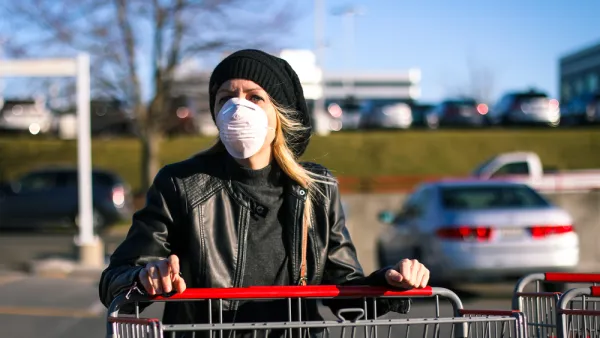While President Trump is publicly stating the virus "will soon disappear," his task force is releasing detailed, county-level data on how all 50 states are dealing with the coronavirus and making recommendations – but the reports are not public.

A 359-page comprehensive report prepared for the White House Coronavirus Task Force details how all 50 states are dealing with the coronavirus and makes recommendations to reduce infections. The July 14 document was obtained by the Center for Public Integrity, a nonprofit newsroom based in Washington, D.C.
"It includes county-level data and reflects the insistence of the Trump administration that states and counties should take the lead in responding to the coronavirus," writes Liz Essley Whyte. "The document has been shared within the federal government but does not appear to be posted publicly."
The report is embedded in Whyte's article, "Exclusive: White House document shows 18 states in coronavirus 'red zone'." Whyte's focus is on those red zone states, "meaning they had more than 100 new cases per 100,000 population last week. Eleven states are in the 'red zone' for test positivity, meaning more than 10 percent of diagnostic test results came back positive."
Just as important as the contents of the report and its recommendation for red zone states, which include reverting "to more stringent protective measures, limiting social gatherings to 10 people or fewer, closing bars and gyms and asking residents to wear masks at all times," is the fact that it is not a public document.
Dr. Ashish Jha, director of the Harvard Global Health Institute, said he thought the information and recommendations were mostly good.
“The fact that it’s not public makes no sense to me,” Jha said Thursday. “Why are we hiding this information from the American people? This should be published and updated every day.”
In fact, the report bears similarity with Harvard's color-coded COVID Risk Level map released July 1 (posted here) that uses almost the same colors to denote the level of risk and is county-specific. Red in the Harvard dashboard means 25 or more new daily cases per 100k people and green less than one case per 100k population. Other than a daily rather than weekly rate, the other difference is that Harvard has a fourth color – orange, while the task force uses only three, with yellow being 10-100 new cases per 100k in the last week.
President Trump and task force send opposite messages
The New York Times also got hold of a task force report and shared it with the public in a way that showed, in its coverage of the White House press briefing on July 28, how President Trump is contradicting the report's findings:
He claimed that “you can look at large portions of our country — it’s corona-free,” even as federal officials distributed a new report finding that 21 states had outbreaks so severe that they were in the “red zone.” Twenty-eight states were in the “yellow zone,” and only one state, Vermont, was in the “green zone.”
And in the section sub-titled, "As Trump called on states to reopen, a federal report urged 21 ‘red zone’ states to impose more restrictions" [source article]:
The report, which was dated July 26, recommended that more restrictions be put in place in “red zone” states. But on Monday, a day later, President Trump called for more states to reopen.
“A lot of the governors should be opening up states that they’re not opening, and we’ll see what happens with them,” Mr. Trump said during a visit to North Carolina — one of the states in the red zone.
As noted in a recent post about the virus moving to rural areas, it's the president's message urging governors to "open-up" that is resonating more strongly with governors like Bill Lee of Tennessee, who rebuffed task force coordinator Deborah Birx's recommendations. "Lee said he would not close bars or limit restaurants or give county mayors the authority to take these actions locally."
Related in Planetizen:
- Pandemic's New Phase: Spreading to Rural and Urban Areas Alike, August 9, 2020
- Do You Know Your COVID-19 Colors? Jul 29, 2020
Hat tip to Ed Pilkington of The Guardian.

Analysis: Cybertruck Fatality Rate Far Exceeds That of Ford Pinto
The Tesla Cybertruck was recalled seven times last year.

National Parks Layoffs Will Cause Communities to Lose Billions
Thousands of essential park workers were laid off this week, just before the busy spring break season.

Retro-silient?: America’s First “Eco-burb,” The Woodlands Turns 50
A master-planned community north of Houston offers lessons on green infrastructure and resilient design, but falls short of its founder’s lofty affordability and walkability goals.

Test News Post 1
This is a summary

Analysis: Cybertruck Fatality Rate Far Exceeds That of Ford Pinto
The Tesla Cybertruck was recalled seven times last year.

Test News Headline 46
Test for the image on the front page.
Urban Design for Planners 1: Software Tools
This six-course series explores essential urban design concepts using open source software and equips planners with the tools they need to participate fully in the urban design process.
Planning for Universal Design
Learn the tools for implementing Universal Design in planning regulations.
EMC Planning Group, Inc.
Planetizen
Planetizen
Mpact (formerly Rail~Volution)
Great Falls Development Authority, Inc.
HUDs Office of Policy Development and Research
NYU Wagner Graduate School of Public Service




























